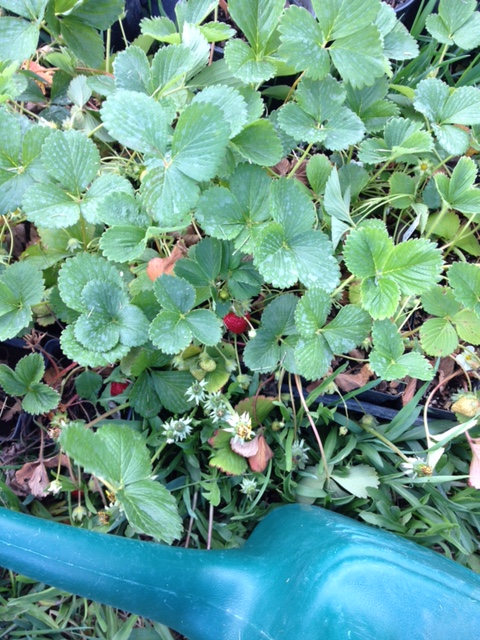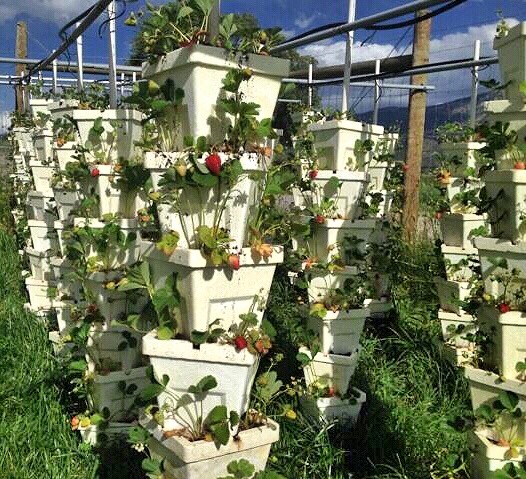When cars pass our house we get a lot of "rubber-necking". Drivers, bikers and runners even stop when they see us working outside to yell through the fence and ask us about our vertical towers. Some people have thought we were housing bees, others ask if they are tomatoes, but a good amount of people know that they are strawberries and just like to ask about how we came up with the system to grow them. It's definitely different, seeing as most people's experience with strawberries are in vast fields usually involving some weed barrier and fallow rows. Not us though. Seeing as we only have a tad over two acres, we strive for efficiency when it comes to space.
This will be our third year growing strawberries. The pots were acquired while I was still an intern from the Living Farm. Over a decade had past since they had been used to grow strawberries hydroponically (without soil) and had been sitting in a shed until I brought up my interest in strawberries. There was also the conduit that held them up in the greenhouse. I fashioned a free standing structure, mixed some soil, purchased a thousand plants, and enlisted some friends to help with the planting, and voila, the plants were starting to grow.
This third season of using this system for growing strawberries is quite pivotal for me. Most wise growers have advised that at least three seasons are necessary to really know a plants tendencies. On this third season we will also be expanding our system by adding more towers using PVC pipes (since the pots are REALLY expensive).
My first year went fairly well in regards to yield and market, considering the set-backs I faced. Installing and using the watering system took some trial and error, which resulted in a loss of about 25% percent of the crop right off the bat. After I figured how much water the plants needed, then came the problem of keeping them fed. The pots themselves were meant for hydroponics, which is a method of growing plants in a growing medium as opposed to soil. Because of this, they are highly efficient in regards to space, but there are two sides to every coin. One pot is essentially an 8 inch cube and fits four plants. This math doesn't quite add up unless you are feeding the strawberries constantly. So again by trial and a good amount of error, I started to feed them after their leaves yellowed and they didn't flower. Finally after a few weeks, I dialed in the feeding system (compost tea and organic fertilizer) and then it was off to the races.
The whole crop produced a bit over 100 pounds of berries, which were mostly sold to one of our local co-ops: The Old River Road Trading Post. What I couldn't sell I froze and later turned into jam which was also sold there. They also made wonderful Christmas gifts. After the season, we put the plants to bed by down-stacking the towers and mulching the pots.
Year two proved to run more smoothly, although not without it's own pitfalls. I replaced the plants that had died off in the first year with runners that were overwintered in a greenhouse, re-stacked the towers, and the season began. I had the watering down this year and had assumed that I would remember the tea mixture, but something went array in the first feeding of the year and the plants got set back almost a full month. Once they recovered though, the plants - especially the second year ones- really produced. We grow a day-neutral variety of strawberry, which means that unlike single season strawberries, they will fruit as long as there is enough warmth. We usually get 3 to 4 big harvests per season.
After re-configuring my tea mixture and a fairly decent scuffle with slugs and earwigs through the early spring, we harvested over 300 pounds of berries. This time, we sold our berries in other local markets which included Delicious Orchards and Lizzy's Market. In 2015, I had some friends start a food distribution company called Farm Runners, who can be found here. It was just in time too, because I had almost saturated the local market, and they were more than willing to take any berries I had.
Surely year 3 would prove to be the smoothest, and I am sure it will be, but it has already proved to be a bit challenging. This winter, I attempted to over winter the plants without down-stacking and mulching, which worked until everything started to thaw out. Here in Western Colorado, we are prone to pretty intense winds in the spring, and I just didn't keep track of the moisture content, and the plants dried out and almost all died. This wasn't too terrible, since I was already planning on replanting most of them anyway. Most of the pots had become over grown, with the average one holding 12 plants. Imagine 8 more roommates in your already cramped studio apartment. As of now, they are all planted and ready for the season, and so are we.




![IMG_5205[1]](https://images.squarespace-cdn.com/content/v1/594847dd1b10e303cc01693b/1504556132668-N2TYIBXH624SNLCXGDRN/img_52051.jpg)
![IMG_5202[1]](https://images.squarespace-cdn.com/content/v1/594847dd1b10e303cc01693b/1504556130662-QRYKAEE2D45NWL3UK57J/img_52021.jpg)
